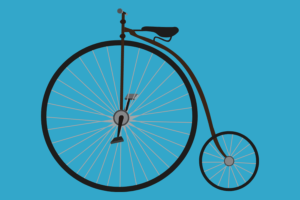Miyata made its mark on the cycling world as one of the most sought-after bike brands in Japan.
Miyata is a name that has been synonymous with quality, reliability, and durability for decades. They are a Japanese bicycle manufacturer that started bike production in the early 1900s.
Known as the first bike company to pioneer the triple-butted frame, they single-handedly revolutionized how bike frames are built today.
Miyata Bike History
Eisuke Miyata was a bower and engineer from Tokyo. For work, he made parts for rickshaws, which are two or three-wheeled passenger carts. His son, Eitarō, was an apprentice in a munitions facility and earned his degree as a mechanical engineer from Kyoto University.
In 1874, Eisuke moved his family to Shiba. A few years later, in 1881, he opened Miyata Manufacturing in Kyōbashi, Tokyo. The business produced guns for the Imperial Japanese Army — which included the Murata rifle — and knives for the Navy.
One day in 1889, a foreigner asked Miyata to repair his bicycle. The factory easily repaired the bike, and from then on continued to repair bikes as a side business.
The next year, in 1890, Miyata opened a new factory in Kikukawa and renamed the company Miyata Gun Works. His son, Eitarō, used rifle barrels from the factory and his knowledge as a mechanical engineer to manufacture the first Miyata prototype bicycle.
In 1892, the crown prince of Japan, Yoshihito, requested that Miyata build him a bicycle. The request boosted their success, but they were still forced to halt production and focus on manufacturing guns during the First Sino-Japanese War of 1894.
In 1900, Japan changed its laws and allowed foreign rifles to be imported. This flooded the market with cheap imports and their gun manufacturing business took a hit. Eisuke died on June 6 of the same year, and Eitarō stopped gun production to focus solely on their Asahi and Pāson bicycle brands.
Miyata Bike Models
Miyata’s first bicycle model was a simple, bolt-upright town bike. Through trial and error, they pioneered triple-butted tubing and revolutionized frame techniques. Soon after, bike sales skyrocketed and they successfully established themselves in the bicycle market.
Series Number System
Miyata bike models were named using a series number system. But the system wasn’t just for show — the first digit indicated the bike level in each series.
For example, the 90 and 100 series are entry-level sports bikes. The 200, 600, and 1000 models are touring bicycles. The 300, 400, 500, 700, and 900 series bikes are mid-range competition and fitness bicycles. For each series, the level of the bicycle increased with the first digit in the series.
On most Miyata bike models, the last two digits of the model number indicated the number of gears — for example, a Miyata 914 was a 9 series, 14-speed bike.
Low To Mid-End Miyata Bike Models
- Miyata 9x: This entry-level model had triple butted tubing and Shimano/Suntour entry-level components.
- Miyata 1xx: Aimed at the casual riders, this lower-level model had Chromoly triple-butted main tubes, toe clips/straps, hi-ten stays, and was available in both mixte and men’s styles.
- Miyata 2xx: The most popular lower-end touring model, it was built with straight gauge tubing, Dia-Compe cantilever brakes, and Shimano triple drive train.
- Miyata 3xx: This mid-range road bike model was from the semi-pro group and was equipped with Shimano 105 brakes, shifters, and derailleurs.
High-End and Competition Miyata Bike Models
- Miyata 5xx: In the “Semi-Pro” group, this bike had a more aggressive geometry.
- Miyata 6xx: A quality model, this bike was one step below the 1000 and had lower-level components and slightly different frame geometry.
- Miyata 7xx: Also in the “Semi-Pro” group, early models had Suntour parts, which included an odd 3-wheel derailleur.
- Miyata 9xx: This high-end road bike was from the “Semi-Pro” group and had Shimano 600 components.
- Miyata 1000: A touring bike with splined, triple-butted Chromo tubing, the 1000 was marketed in the U.S in the late 19070s and North American until 1993.
- Miyata 1400: This high-end road bike was sold as a 1989 model with Shimano 600 components and CrMo triple-butted construction.
- Miyata Pro/Team/1200: These high-end models came race-ready.
- Miyata Cross: These models were top-of-the-line and included the Quickcross, Sportcross, Alumicross, and Triplecross. Introduced in the late 1980s, the Alumicross came with standard-sized aluminum main tubes bonded to steel lugs and a Chromo fork. The seat and chainstays were steel, and the seat post binder bolt held the seat stays to the seat post lug. The Sport, Quick, and Triplecross were triple-butted.
Are Miyata Bikes Available Today?
While the Miyata brand still exists today, their bikes are no longer distributed in the United States. They joined forces with the Dutch Koga bicycle manufacturing brand under the name Koga-Miyata until 2010.
In 2011, Miyata announced plans to sell bikes under the Miyata Japan brand. They advertised new frames modeled after the Koga-Miyata bike that Peter Winnen rode when he won a stage of the 1981 Tour de France. These frames would be custom and hand-built with their traditional Chromoly steel process.
While it might be hard to find a good condition Miyata bike on the market, it isn’t impossible. Check out Craigslist, eBay, or your favorite cycling forum to start your search.
Do you own a piece of Miyata bike history? Grab an insurance plan for as little as $8/month and protect your bicycle from theft, damage, and more.

